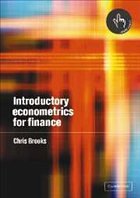This is the first textbook to teach introductory econometrics to finance majors. The text is data- and problem-driven, giving students the skills to estimate and interpret models, whilst having an intuitive grasp of the underlying theoretical concepts. The approach of Dr Brooks, based on the successful course he teaches at the Cass Business School, one of Europe's leading business schools, ensures that the text focuses squarely on the needs of finance students, including advice on planning and executing a project in empirical finance. The book assumes no prior knowledge of econometrics, and covers important modern topics such as time-series forecasting, volatility modelling, switching models and simulation methods. It includes detailed examples and case studies from the finance literature. Sample instructions and output from two popular and widely available computer packages (EViews and WinRATS) are presented as an integral part of the text.
Table of contents:
1. Introduction; 2. Econometric packages for modelling financial data; 3. A brief overview of the classical linear regression model; 4. Further issues with the classical linear regression model; 5. Univariate time series modelling and forecasting; 6. Multivariate modelling; 7. Modelling long-run relationships in finance; 8. Modelling volatility and correlation; 9. Modelling regime shifts; 10. Simulation methods; 11. Conducting empirical research in finance; 12. Conclusions: recent and future developments in the modelling of financial time series; References; Appendix. Review of matrix algebra, calculus, and probability theory; Statistical tables.
An introductory econometrics book for finance students. The approach adopted is data and problem driven, giving students the skills to estimate and interpret models, while having an intuitive grasp of the underlying theoretical concepts. The book assumes no prior knowledge of econometrics, and covers important modern topics.
The first textbook to teach introductory econometrics to finance majors.
Table of contents:
1. Introduction; 2. Econometric packages for modelling financial data; 3. A brief overview of the classical linear regression model; 4. Further issues with the classical linear regression model; 5. Univariate time series modelling and forecasting; 6. Multivariate modelling; 7. Modelling long-run relationships in finance; 8. Modelling volatility and correlation; 9. Modelling regime shifts; 10. Simulation methods; 11. Conducting empirical research in finance; 12. Conclusions: recent and future developments in the modelling of financial time series; References; Appendix. Review of matrix algebra, calculus, and probability theory; Statistical tables.
An introductory econometrics book for finance students. The approach adopted is data and problem driven, giving students the skills to estimate and interpret models, while having an intuitive grasp of the underlying theoretical concepts. The book assumes no prior knowledge of econometrics, and covers important modern topics.
The first textbook to teach introductory econometrics to finance majors.

